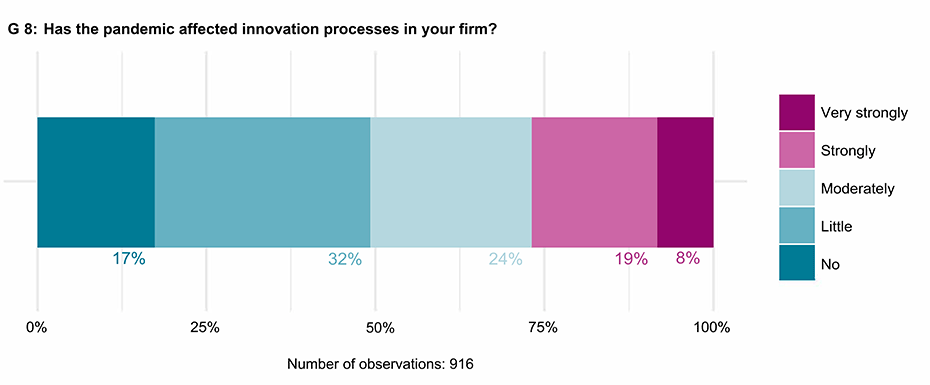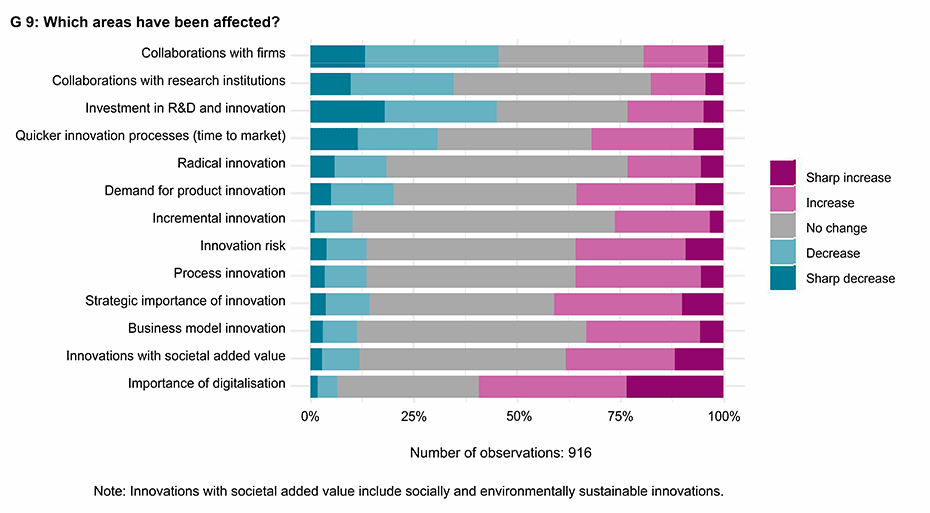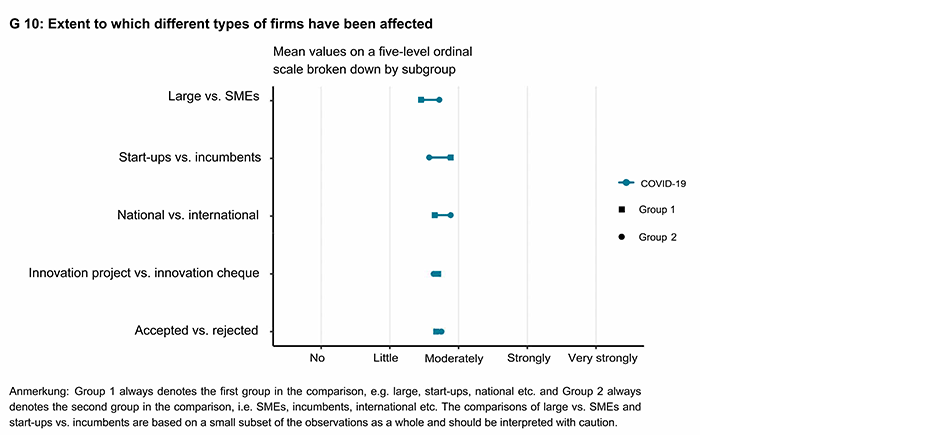The innovation activities of Swiss companies during the COVID-19 crisis
The coronavirus pandemic has clearly left its mark on Switzerland’s innovation landscape. More than a quarter of the firms surveyed by KOF have had to adapt their innovation processes significantly or even very significantly owing to the COVID-19 crisis. SMEs, start-ups and multinational corporations have been hit particularly hard. Just under half of these companies report that COVID-19 has meant a reduction in R&D and innovation investment and a decline in innovation collaborations.

There is both theoretical (see Bernanke and Gertler; 1989, Barlevy, 2007) and empirical evi-dence (see Guellec and Ioannidis, 1999; Mairesse et al., 1999; Rammer et al., 2004; Quyang, 2011a) to suggest that firms invest pro-cyclically in research and development (R&D) and innovation. This means that they increase their spending during good economic times and cut back during times of crisis. There are many reasons for this behaviour. Essentially, it depends on firms’ financial resources, which improve when the economy is doing well and deteriorate when it is faring badly. Since 87 per cent of Swiss companies finance their R&D internally (Swiss Federal Statistical Office 2021), their financial resources are of great importance.
High-tech firms typically invest in R&D even in times of crisis
However, there is one type of company that manages to invest in R&D despite any adverse macroeconomic situation, i.e. they increase their investment in times of crisis. Consequently, they benefit from lower costs and can exploit the growing market potential during the subsequent recovery by using their improved or newly developed products and services. These are usually R&D-intensive firms and relatively large companies in the high-tech sector of the economy that face low price competition and cooperate with external partners – especially universities (see Arvanitis and Woerter, 2014).
The extent to which we have also observed this investment pattern during the COVID-19 pandemic is open to debate. Some factors suggest that things are different in this case. On the one hand, there has been strong demand for specific innovative products and services in the healthcare sector (e.g. vaccines, masks and medicines) owing to the drastic public health policy measures taken but, on the other hand, it has been more difficult to maintain innova-tion collaborations or forge new ones because of mobility restrictions, while the digitalisation of products and services and related new business models have gained in importance.
A sample of innovative firms that have applied for support from Innosuisse – the leading innovation promotion agency in Switzerland (see box) – gives an initial impression of how much the innovation activities of companies (especially SMEs) have been affected by the COVID-19 crisis and how much innovation-related activities have changed.
More than a quarter of the companies surveyed (27 per cent) report that the pandemic has had a strong or even very strong impact on their innovation processes, while about half of firms claim that they have not been affected or have been only slightly affected (see Chart G 8). However, this does not say anything about the type of impact, i.e. whether companies have been negatively or positively affected or what type of firm has been more or less affected.
About half of the innovative companies surveyed report that the COVID-19 crisis has brought a reduction in R&D collaborations with other firms and a decline in investment in R&D and innovation projects (see Chart G 9); to a somewhat lesser extent they have reduced cooperation with research institutions. In contrast, some firms (between 18 per cent and 23 per cent) have increased their activities or investment in all three areas. Many of these are companies that have benefited particularly from the pandemic-related increased demand for digital solutions, certain medicines, medical equipment and logistical solutions. Alternatively, they have been able to use internally available resources to launch new innovation projects owing to the decline in orders, and they have thus invested countercyclically in the development of new products and services.
Pandemic provides impetus for digitalisation
Around 60 per cent of the firms surveyed report an increase in the importance of digitalisation in their innovation activities. This pandemic-related, trend-setting impetus for innovation projects represents a major challenge for many companies owing to the changed demands on new products and services. This may entail developing new business models or adjusting the qualifications required of researchers. At the same time, this digitalisation push offers agile firms an opportunity to expand their markets or enter new markets through product differentiation. The survey’s findings show that the strategic importance of innovations has increased for around 40 per cent of companies.
The importance of social innovations (innovations with societal added value) has grown for 38 per cent of the firms surveyed, while the importance of product and process innovations has increased overall for a similarly high proportion of companies. At the same time, the innovation risk – i.e. the ratio of cost to the probability of succeeding with the development of a new product – has increased for more than a third of companies, which may be related to the growing importance of marketing speed (time to market) for many firms. The sooner a product or service is brought to market, the greater the competitive advantage tends to be and the longer the firm concerned can benefit from higher margins. Marketing speed has become a more decisive factor in the commercial success of innovations for about 30 per cent of the companies surveyed.
Although innovation has become increasingly important among the firms surveyed, many of them have had to cut back on innovation investment. This suggests that some innovation options might not be explored because of a lack of financial resources. This could indicate scope for pandemic-related innovation support measures that enable companies to generate innovations in times of crisis despite the challenging macroeconomic environment so that they can benefit from them commercially once the economy recovers.
Supply chain problems are hampering multinational companies in terms of their innovation processes
Chart G 10 shows that SMEs have been more seriously affected by the pandemic than large companies. Start-ups have been hit harder than established businesses, probably because they are usually less diversified, suffer more from mobility constraints – making it more difficult to build business relationships – and have a thinner equity base with which to finance R&D and innovation. However, some start-ups may have benefited from the pandemic, for example as a result of the high demand for digitalised business processes. Such adjustments are easier to make in small firms than in larger ones. Given the problems with global supply chains, it is less surprising that multinational companies are more likely to have been affected by the COVID-19 pandemic in terms of their innovation processes. They have had to adapt their innovation efforts accordingly in certain pre-production areas, for example by limiting their consumption of materials by implementing innovative measures or switching to more readily available materials. Whether or not a company has been successful in applying for Innosuisse funding (for innovation projects) is not related to whether it has been affected by the pandemic.
This survey is based on a sample of 3,597 firms that have applied to Innosuisse for innovation funding since 2016. Of these contacted companies, 1,057 responded, which equates to a response rate of 29 per cent1. The study was conducted on behalf of Innosuisse.
-----------------
1 The statements made are not representative of the entire Swiss economy. In addition, the results may be distorted by different response probabilities or missing information – when answering the questionnaire – on company characteristics such as size and age.
Literature
Arvanitis, S., & Woerter, M. (2014): Firm characteristics and the cyclicality of R&D investments. Industrial and Corporate Change, 23(5), 1141-1169. Retrieved from http://icc.oxfordjournals.org/cgi/doi/10.1093/icc/dtt013
Barlevy, G. (2007): On the cyclicality of research and development, American Economic Review, 97(4), 1131-1164.
Bernanke, B. and M. Gertler (1989): Agency costs, net worth, and business fluctuation, American Economic Review, 79(1), 14-31.
FSO (Federal Statistical Office) (2021): Intramuros R&D expenditure, by source of funding, 2000-2019, Research and development (R&D) in the private sector, Neuchâtel
Guellec, D. and E. Ioannidis (1999): Causes of fluctuations in R&D expenditures: a quantitative analysis, OECD Economic Studies No. 29, pp. 124-138.
Mairesse, J., B. Hall, L. Branstetter and B. Crepon (1999): Does cash flow cause investment and R&D? An exploration using panel data for French, Japanese, and United States Scientific Firms, in D. Audretsch and R. Thurik (eds), Innovation, Industry Evolution and Employment. Cambridge University Press: Cambridge, pp. 129-156.
Rammer, C., H. Penzkofer, A. Stephan, C. Grenzmann, D. Heger and O. Nagel (2004): R&D and innovation behaviour of SMEs and large firms under the influence of the business cycle. Federal Ministry of Education and Research: Mannheim, Germany.
Quyang, M. (2011a): On the cyclicality of R&D, Review of Economics and Statistics, 93(2), 542-553.
Contacts
KOF Konjunkturforschungsstelle
Leonhardstrasse 21
8092
Zürich
Switzerland
KOF FB Innovationsökonomik
Leonhardstrasse 21
8092
Zürich
Switzerland



